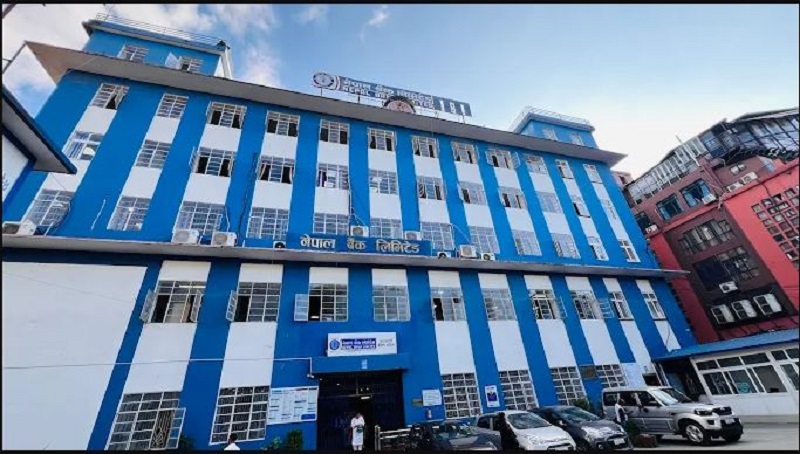NBL Records Profit Surge Amidst a Distributable Profit Paradox
14th August 2025, Kathmandu
Nepal Bank Limited has delivered an extraordinary performance in the fiscal year 2024/25, reporting a net profit of NPR 3.77 billion. This marks a staggering 13,175% surge from the mere NPR 28.4 million earned in the previous fiscal year, signaling a major turnaround for the public sector institution.
NBL Records Profit Surge
While this headline figure is cause for celebration, the financial report reveals a crucial and complex detail: the bank’s distributable profit remains negative, at NPR 449.08 million. This paradox of high profit with no dividend-paying capacity is the most significant aspect of the report and requires a detailed understanding of the bank’s financial history.
The remarkable profit growth was fueled by robust performance across core banking operations, demonstrating the bank’s ability to generate strong revenue despite a challenging economic environment. The results showcase a path of recovery and operational efficiency that positions the bank for future stability.
Unpacking the Profit Explosion: A Story of Recovery and Strategic Management
The eye-popping 13,175% profit growth is not a result of a one-time windfall but a recovery from a very low base in the previous year. A deeper analysis shows that the profit for FY 2080/81 was significantly hampered by massive loan loss provisions. In contrast, the current fiscal year saw a steep reduction in impairment charges from NPR 4.76 billion to a more manageable NPR 1.14 billion. This reduction in the provisioning for bad loans is a primary driver of the profit surge.
Alongside this, the bank’s core business saw genuine and healthy growth. The net interest income, which is the profit from a bank’s core lending and borrowing activities, increased by a solid 16.82% to NPR 10.08 billion. This indicates that the bank’s loan book is performing well and it is effectively managing its interest rate spreads. The total operating income also grew by 15.65% to NPR 11.94 billion, while the operating profit jumped by a massive 692% to NPR 5.41 billion. This growth in operating profit, driven by both strong interest and non-interest income, reflects a significant improvement in the bank’s operational efficiency and cost management. The bank’s net fee and commission income also saw a respectable rise of 6.07% to NPR 1.17 billion, highlighting successful diversification of revenue streams.
The Distributable Profit Paradox: What It Means for Shareholders
For investors, the most critical aspect of the report is the negative distributable profit of NPR 449.08 million. While the bank made a net profit of NPR 3.77 billion, this profit cannot be distributed as dividends. This is due to a fundamental accounting principle and regulatory requirement: a bank must first clear any accumulated losses from previous years before it can distribute profits to its shareholders.
Historically, Nepal Bank has had periods of high non-performing loans and financial strain, which led to significant accumulated losses. The current year’s profit, while impressive, has not been enough to completely offset these prior-year losses. The distributable profit is essentially the remaining profit after all statutory reserves have been allocated and all accumulated losses have been covered. The negative figure indicates that a portion of the current year’s profit has been used to narrow the gap of accumulated losses, which is a positive step toward future dividend distribution. The bank’s retained earnings, a key component of distributable profit, have improved significantly from a negative NPR 965.07 million to a negative NPR 449.08 million, showing it is on the right track.
Asset Quality, Capital Strength, and Future Outlook
While the financial results show a strong turnaround, it is important to address the bank’s asset quality. The Non-Performing Loans (NPLs) saw a slight increase to 4.47% from 4.33% in the previous year. Although this figure is an improvement from recent years, it remains a point of caution and is still above the industry average. This indicates that a portion of the bank’s loans are still under stress, and continued vigilance in credit management and loan recovery will be essential to sustain profitability.
On the positive side, Nepal Bank’s balance sheet remains exceptionally strong. It has a paid-up capital of NPR 14.69 billion and a massive reserve fund of NPR 23.93 billion, which is one of the highest in the industry. This strong capital position provides a robust buffer against unexpected losses and gives the bank the stability needed for future expansion. The bank’s Earnings Per Share (EPS) has jumped from a paltry NPR 0.19 to NPR 25.68, and its Net Worth Per Share stands at an impressive NPR 259.81. These metrics, while not translating to an immediate dividend, demonstrate the bank’s inherent value and potential for future shareholder returns.
Nepal Bank Limited’s FY 2024/25 financial report is a powerful testament to its operational recovery and improved efficiency. While the negative distributable profit signals that shareholders will have to wait for dividends, the report’s strong growth in core income and operating profit provides a clear roadmap toward sustainable profitability and value creation. The bank’s strong capital base and renewed operational focus position it well to address its lingering NPL issues and become a formidable force in the Nepali banking sector.
For More: NBL Records Profit Surge








